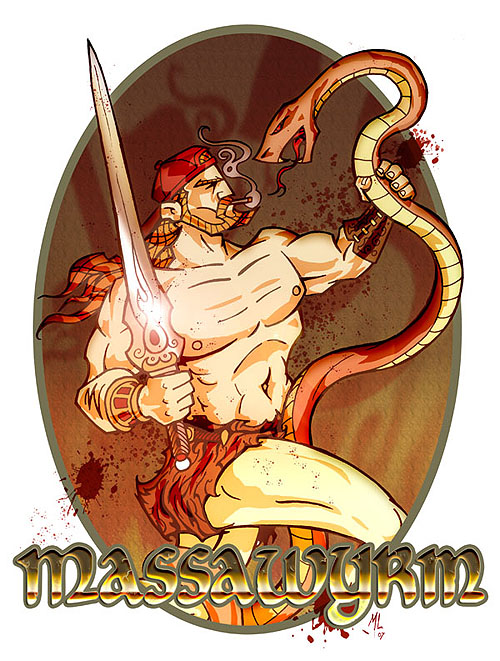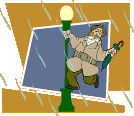Hola all. Massawyrm here.
PLAYERS HANDBOOK 2 (PHB2)
Well, now that SXSW is over and I’ve finally caught up with the bulk of my writing, I’ve finally been able to settle down with Players Handbook 2. The highly anticipated, much bemoaned second installment of the Players Handbook series, this is the book that further expands the players options with new races and classes, many adapted from earlier editions of the game. Many 3rd edition holdovers complained that they wouldn’t enter the 4E fray until the 3rd edition classes (many of which weren’t standard classes before 3rd) were available to continue their existing campaigns, or to allow them to play the kinds of characters and races they wanted. Well, now all but one of them are here.
The important thing to note about the book is that it contains new races, new classes, feats for both (with only a few crossover classes for previous classes) and little else. There are some new magic items, epic destinies and a rules update – but 175 of the 224 pages is entirely dedicated to the new arrivals. This isn’t at all like the 3E PHB2 which had all sorts of new stuff for everybody plus new classes (as well as a shitload of powercreep to go with it.) It is an extension of the old book that isn’t so much a MUST OWN as a player unless you want to play one of the new races/classes.
Race-wise the book is solid. Half-orcs ROCK in a big way and will most likely be the next race I suit up with. Now that D&D is all about no initial penalties, Half-orcs aren’t typified by their dumb, uncharismatic modifiers. Instead they’re strong and hella fast. Half-orcs gain a +2 speed bonus on the charge that makes them great defenders or strikers, getting a longer range to stick in with. And their furious assault power allows them to beef up an attack once per encounter as a free action. ALWAYS cool when you can do that. Also returning is the 3E creation the Goliath (probably the best thing to come out of the RACES books), the highly anticipated (for some ungodly reason) Gnome, and Eberron’s Shifter (because we couldn’t just put the Eberron races in the upcoming Eberron books…). The book’s new addition is the Deva, replacing the Aasamir as the in game alternative to the Tiefling.
Statwise the Deva is lacking. Powergamers will shun it altogether unless they are playing in an undead heavy campaign (they come with built in 5+1/2 level Radiant and Necrotic resistance), and will probably end up used by fluff heavy players. Their racial power is a once per encounter extra d6 on a single roll – kind of a poor man’s Elven Accuracy, good only for rolls you only kind of miss by. A racial feat bumps this to a d8. Although if you’re playing Paragon level, the Paragon feat to modify this lets you not expend the power if it still fails after your roll. Overall it surly isn’t the worst power to have, just not as useful as some of the others.
But the book really shines when you look at the 8 new classes. Focusing on PRIMAL, ARCANE and DIVINE classes, the book offers not only a bevy of previous game options (the sorcerer, bard, barbarian and druid) but it also presents 4 new classes that all add great flavor to the game. What I like best about the book is that it can exist entirely on its own in a campaign – that is to say you could run the classes from your next campaign entirely from this book and have all of your bases covered. You’ve got a great offensive healer with the Shaman – which is effectively a healing druid (much like the rare 3E build). There’s the warden, which is effectively an offensive close combat druid (like the rare 3E build). The Avenger is a divine striker that is effectively a really offensive Paladin. And finally there’s the Invoker, which is a divine wizard throwing about the power of the god’s and summoning bad ass beasties to do its bidding.
Each of the classes is really evocative, chock full of fluff and can easily be used as the bulk of a Classic Mythical Greek, Mesoamerican or woodland themed campaign. Pretty much anything that deals with the gods or the forest will benefit strongly from this book – as will conversions of older campaigns waiting for things like the Bard and the Barbarian to show up. Of the new conversions I’m particularly drawn to the Sorcerer and Druid. The sorcerer is VERY different from a Wizard now and both can exist within a campaign without feeling like strange facsimiles of one another. The Sorcerer is a striker with two VERY DIFFERENT paths – Dragon based power or wild magic (Yay! Wild magic is back!) The former is a very aggressive STR based magic while the latter comes with all sorts of really neat beneficial effects that pop up if you roll a certain way (often based off even or odd attack rolls.)
The downside is there are a handful editing snafus that snuck in, the grossest of which is a 1st level sorcerer daily erroneously listed as doing 6d6 (with half damage on a miss.) And if you’re a player locked into a long running campaign, there’s very little this book will have to offer you until it’s time to make a new character.
Overall, the book is pretty much a must have for any DM who will love the inspiration and want to keep this handy for players to thumb through for feats, rituals and the occasional magic item, but players will most likely only have it on their shelf if they ever feeling like saddling up one of these cool classes. That said, I think it’s a great addition to any campaign and a great basis for a campaign of its own.
DUNGEONS & DRAGONS POWER CARDS
This one was and is a no brainer and doesn’t really need much of a write up. They are all the powers from the players guide for a single class ready and available in a handy card form. If you’re the type of person who hates writing down all the info about your powers onto those printable cards – or you aren’t using (or don’t like) the one’s from the character builder – then this is the product for you. They are playing card sized data cards with everything you need to know about your powers – especially handy for those folks who like to swap their powers frequently. They are color coded exactly as in the book and contain all the relevant data in an easy to read format.
They offered me a copy of whichever class I wanted (right now only the PHB1 classes are available) and I opted for the Paladin, my wife’s current class. She HATES transferring the info from the book, so I just saved her a couple of hours work over the course of our long running campaign. It’s neat, nifty and wholly unnecessary. This is one of those great products for someone who likes to spend a little coin on their new character or as a convenience for those of us who love professional looking products to play with. Especially recommended for you beginners still struggling with the rules and such, or who would just rather spend your time playing rather than transcribing.
Until next time friends, smoke ‘em if ya got ‘em.
Massawyrm
Got something for the Wyrm? Mail it here.

